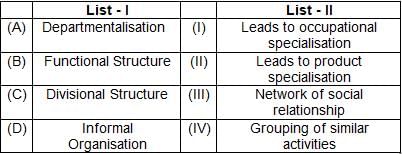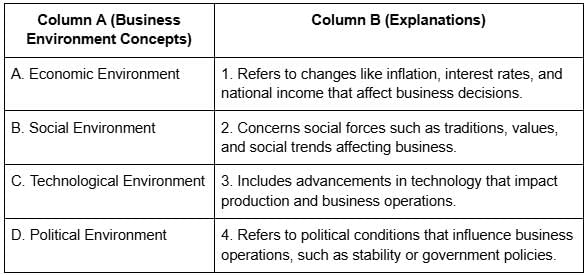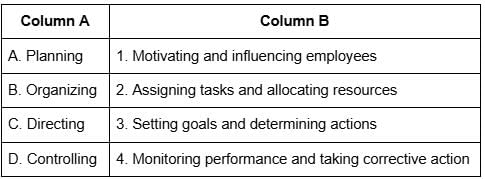Business Studies: CUET Mock Test - 2 - CUET MCQ
30 Questions MCQ Test - Business Studies: CUET Mock Test - 2
Which event increases the demand for Namchi Designer Candles?
What is the main product of Namchi Designer Candles?
How did Smita Rai overcome the challenges she faced?
Which award did Smita Rai receive for her business efforts?
What was Smita Rai’s main objective when starting her business?
‘Taylor believed that the management should share the gain with workers’. Identify the principle of management as referred to in the above line.
Match List - I with List - II.

Choose the correct answer from the options given below :
(A) Identifying and dividing work into manageable activities to avoid duplication.
(B) Grouping similar activities into departments to facilitate specialisation.
(C) Assigning duties to employees based on their skills and competencies.
(D) Establishing informal communication channels to enhance employee interaction.
Which of the following options are correct?
Identify the correct sequence of steps in the selection process:
(A) Preliminary Screening
(B) Selection Tests
(C) Employment Interview
(D) Medical Examination
Choose the correct answer from the options given below:
(A) It is the sum total of all external forces that affect a business enterprise’s performance.
(B) It is dynamic, constantly changing due to technological advancements or shifts in consumer preferences.
(C) It is predictable, allowing businesses to forecast future trends with certainty.
(D) It includes specific forces like customers and suppliers that directly impact individual firms.
Which of the following options are correct?
Directions: Read the following text and answer questions on the basis of the same.
Krishan was fascinated by designing jewellery during one of the extracurricular activities in his school. As part of the project, two managers were given the authority to set deadlines for the jewellery designs. They could assign a maximum deadline of 10 to 15 days depending on the complexity of the design. However, only Krishan had the authority to set deadlines shorter than 10 days because he had a better understanding of the business requirements.
Question:
Which principle of management is illustrated by the fact that the two managers could assign deadlines within a certain range, but only Krishan had the authority to assign a deadline shorter than 10 days due to his superior understanding of the business?
Identify the correct sequence of Maslow’s hierarchy of needs from lowest to highest level:
(A) Physiological Needs
(B) Safety Needs
(C) Belongingness Needs
(D) Self-Actualization Needs
Choose the correct answer from the options given below:
Which principle of management is violated when Aman, a worker in Malik Crafts Limited, through his personal experience, was able to identify the time-saving techniques of production but when he approached management with his suggestion he was not appreciated?
The employees should be judiciously penalised for their actions against the organisation is indicated in
Who is credited with the idea of breaking the work and responsibility between labor and management to optimize task performance?
Planning is an intellectual process that requires logic rather than wishful thinking. Which feature of planning is highlighted by the statement?
According to Taylor, management should not close its ears to any constructive suggestions made by the employees. They should be rewarded for their suggestions which results in substantial reduction in costs. They should be part of management and, if any important decisions are taken, workers should be taken into confidence. At the same time workers should desist from going on strike and making unreasonable demands on the management. Both should realise that they need each other. In fact, when there will be open communication system and goodwill there will be no need for even a trade union. Paternalistic style of management, whereby the employer takes care of the needs of employees, would prevail as in the case ofjapanese companies. Identify the principle of scientific management highlighted in the above paragraph.
Management principles are not as _______ as principles of pure science.
(A) Implementing the plan
(B) Evaluating alternative courses
(C) Follow-up action
(D) Selecting an alternative
Choose the correct answer from the options given below:
Management control is done by the __________________
A doctor has to obtain certificate from the Medical Council medical profession. Which feature of the profession is revealed here?
(A) It is a continuous process, requiring new plans to be drawn based on changing requirements.
(B) It is an exclusive function of top management and not required at lower levels.
(C) It involves decision making by choosing among alternative courses of action.
(D) It is a mental exercise requiring foresight, imagination, and sound judgment.
Which of the following options are correct?
Mr. Rahul's problems must be looked after by which department?
"It is the process of influencing the behaviour of people by making them strive voluntarily towards achievement of goals".
Identify the process from the case study:
Identify the incentive used to motivate Mr. Rahul.
Identify the factor which was not responsible for the gradual decrease in the performance of Mr. Rahul.





















